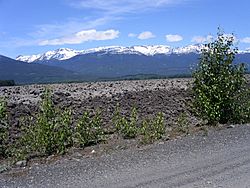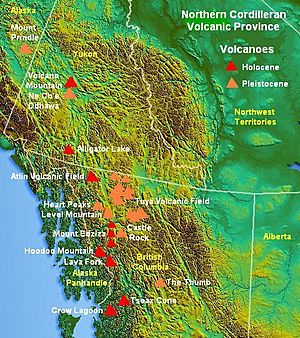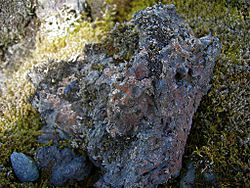Tseax Cone facts for kids
Quick facts for kids Tseax Cone |
|
|---|---|

Tseax Cone
|
|
| Highest point | |
| Elevation | 610 m (2,000 ft) |
| Geography | |
| Location | British Columbia, Canada |
| Parent range | Nass Ranges |
| Topo map | NTS 103J/2 |
| Geology | |
| Age of rock | Historical |
| Mountain type | Cinder cone |
| Volcanic arc/belt | Northern Cordilleran Volcanic Province |
| Last eruption | 1690 ± 150 years (18th deadliest eruption of all time) |
| Climbing | |
| Easiest route | drive |
The Tseax Cone (pronounced SEE-aks) is a young and active volcano in British Columbia, Canada. It is also known as the Tseax River Cone or the Aiyansh Volcano. This volcano is a type called a cinder cone, which is a cone-shaped hill made of volcanic ash and rock pieces.
Tseax Cone is found in the Nass Ranges, which are part of a larger area of volcanoes called the Northern Cordilleran Volcanic Province. It is located about 60 kilometers (37 miles) north of Terrace, British Columbia. The volcano sits in a valley above the Tseax River, about 20 kilometers (12 miles) south of where the Tseax River meets the larger Nass River. It is one of the easiest volcanoes to reach in British Columbia.
Contents
What is Tseax Cone?
The Tseax Cone is part of the Pacific Ring of Fire, a large area around the Pacific Ocean where many earthquakes and volcanic eruptions happen. This volcano has had some of Canada's most recent eruptions. It has erupted at least twice in the last few hundred years.
The base of Tseax Cone is about 290 meters (950 feet) wide. It sits on top of an older, larger cone that was about 460 meters (1,510 feet) wide. The volcano is made of volcanic bombs (rock pieces thrown out by the volcano) and cinders. At its top, there is a volcanic crater, which is a bowl-shaped opening. During its 18th-century eruption, a churning lava lake overflowed from this crater.
Why Does Tseax Cone Erupt?
Volcanoes like Tseax Cone erupt because the Earth's outer layer, called the Earth's crust, is breaking apart. This process is called rifting. Here, two parts of the North American Plate are slowly moving away from each other. This movement is linked to the Pacific Plate sliding northward along the Queen Charlotte Fault.
What Kind of Lava Does it Produce?
The lava that comes out of Tseax Cone is very fluid, meaning it flows easily. This lava is called basalt. Basalt is a common dark-colored volcanic rock that cools quickly on the Earth's surface. It has low silica content, which makes it flow smoothly.
You can find two main types of basaltic lava at Tseax Cone:
- Pāhoehoe: This lava has a smooth, wavy, or rope-like surface. It often forms lava tubes, which are tunnels created when the outer layer of lava cools and hardens, but the hot lava inside keeps flowing.
- ʻAʻā: This lava has a rough, broken, or rubbly surface made of sharp, jagged pieces called clinker. The clinkery surface covers a dense, active core of flowing lava.
The 17th-Century Eruption

Between 1668 and 1714, Tseax Cone had a major eruption. A large flow of lava traveled into the Tseax River, blocking it and creating Lava Lake. The lava then flowed about 11 kilometers (7 miles) north to the Nass River. It filled the valley floor there for another 10 kilometers (6 miles). In total, the lava flow was about 22.5 kilometers (14 miles) long.
In the Nass River valley, you can still see many tree casts and lava tubes. Tree casts formed when the hot lava burned away tree trunks, leaving holes in the hardened lava. Lava tubes formed when the fluid lava flowed underground, leaving empty tunnels after the lava drained away.
Impact on the Nisga'a People
The Nisga'a people, who live in the area, have ancient stories about this eruption. Their legends describe a long period of trouble caused by the volcano. Two Nisga'a villages were destroyed. Many Nisga'a people tried to find shelter by digging pits. However, about 2,000 Nisga'a people died from poisonous volcanic gases, most likely from carbon dioxide that caused them to suffocate. This event is known as Canada's worst natural disaster caused by a volcano.
The lava beds, which are up to 12 meters (39 feet) high in some places, are the burial ground for these people. This is the only volcanic eruption in Canada where the stories of First Nations people have been proven true by science. The lava flow can still be seen near modern Nisga'a villages, like Gitlakdamix. This eruption is just one of many that have shaped the landscape of western Canada over millions of years.
Some scientists think that the Tseax eruption might have been connected to the huge 1700 Cascadia earthquake that happened on January 26, 1700. This was the most powerful earthquake in the Pacific Northwest in the last 1,000 years. If this idea is correct, it means that major earthquakes could also lead to volcanic eruptions.
Before the 17th-century eruption, Tseax Cone had also erupted in 1325.
Could Tseax Cone Erupt Again?
Today, the volcano is quiet, or dormant, and is located within Nisga'a Memorial Lava Beds Provincial Park. However, gases are still coming out of the volcano. This shows that it is still active and could be dangerous. If the volcano were to become restless, there would likely be warning signs. These could include small earthquakes and an increase in gas coming out. These signs would happen before any new eruption.
If Tseax Cone were to erupt again, its effects would be felt across British Columbia. There could be another disaster from poisonous gas, similar to what happened to the Nisga'a people during the last eruption. If the lava flows are very large, they could start forest fires and block local rivers. This would harm the local environment and the important salmon fisheries in the Nass River system.
Scientists need to continue studying and watching the volcano. This will help them predict when Tseax Cone might erupt again. Such predictions could give people living nearby enough time to leave the area safely, much like what happened before the 1980 eruption of Mount St. Helens.
Images for kids




